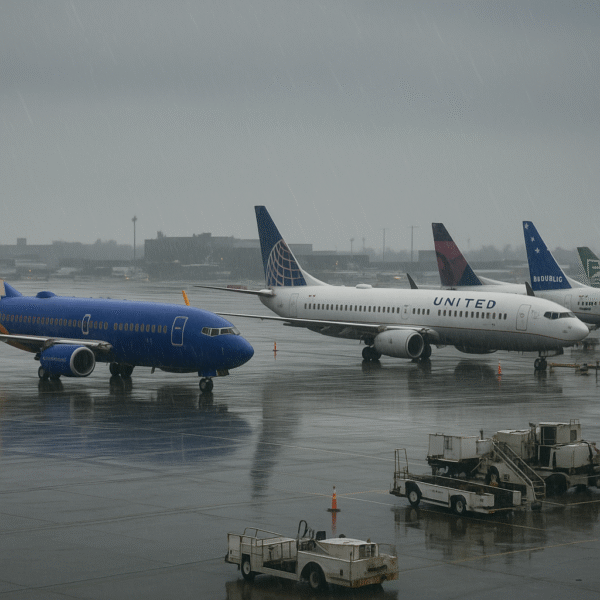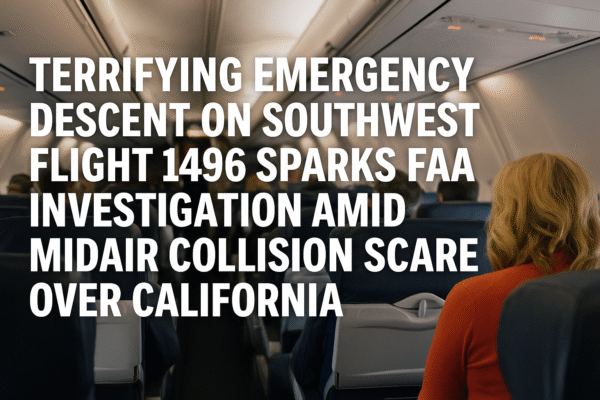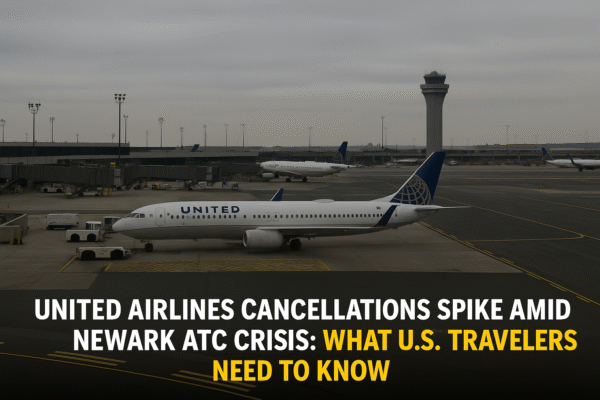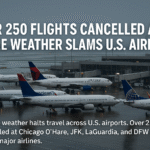The U.S. air travel system is facing a severe operational challenge as United Airlines experiences a wave of cancellations at Newark Liberty International Airport, driven largely by a critical shortage of air traffic controllers (ATC). As one of the busiest air hubs in the northeastern United States, Newark’s staffing crisis has created ripple effects throughout the national aviation network, prompting government agencies to initiate urgent reforms.
On a single day, United Airlines was forced to cancel 35 flights from Newark—roughly 10% of its daily operations at the airport—leaving thousands of travelers stranded or delayed. According to the Federal Aviation Administration (FAA), the cause is twofold: a longstanding shortage of certified ATC personnel and outdated radar and communications infrastructure.
Root Causes: ATC Shortages and Outdated Tech
The situation at Newark Liberty has been deteriorating for months. As reported by the U.S. Department of Transportation, more than 20% of air traffic controllers at Newark’s tower are either unfilled or inactive roles. This shortage severely limits the FAA’s capacity to manage the dense volume of traffic along the East Coast corridor, especially during peak travel periods.
In addition, technological failures have added to the chaos. Radar glitches, communication breakdowns, and aging software systems have contributed to flight mismanagement and delays. United Airlines CEO Scott Kirby has publicly criticized the FAA’s inability to meet growing demand, especially as post-pandemic travel rebounds and summer travel surges.
Government Response: FAA Reform and Recruitment Drive
In response, the FAA has pledged an aggressive overhaul of its staffing and technology initiatives. FAA Administrator Mike Whitaker recently announced that the agency will accelerate the hiring of 1,500 new air traffic controllers nationwide by the end of 2025, with a strong focus on high-traffic hubs like Newark, LaGuardia, and JFK.
To modernize systems, the FAA is investing in the NextGen Air Transportation System, a multi-billion-dollar initiative aimed at replacing legacy radar-based infrastructure with satellite-based GPS navigation. However, industry experts caution that full implementation could take several years, leaving travelers exposed to ongoing delays in the interim.
Meanwhile, the National Air Traffic Controllers Association (NATCA) has called for increased funding and expedited training protocols to ensure that new hires can begin work quickly and safely. Currently, the training period for ATC roles can take up to two years.
Airlines and Passengers Bear the Brunt
Airlines, especially United, have had to adjust their schedules significantly. The airline confirmed that it will proactively reduce flights from Newark during congested time slots to avoid cascading delays. These measures, however, mean fewer options for passengers and higher fares during peak travel times.
Travelers at Newark have reported average delays exceeding 90 minutes, with cascading impacts on connecting flights across the country. Other airports, including Chicago O’Hare, Boston Logan, and Washington Dulles, have also reported residual disruptions from the Newark bottleneck.
“I arrived four hours early for my flight, and I still missed it due to constant gate changes and delayed communications,” said Emma Green, a business traveler attempting to fly to Chicago from Newark. “It’s frustrating and exhausting.”
Economic and Tourism Implications
The disruptions are not only inconveniencing travelers but also threatening tourism-dependent sectors across the country. Cities like New York, Washington D.C., and Chicago rely heavily on consistent air connectivity to support business travel, conferences, and leisure tourism.
According to the U.S. Travel Association, flight delays and cancellations in the first half of 2025 have already cost the travel industry an estimated $1.5 billion in lost revenue. Hotels, restaurants, and local businesses near major hub airports report declines in customer traffic as travelers cancel or reschedule plans.
Travel Advisory: What Passengers Should Do
As air traffic challenges persist, the FAA and airlines are advising travelers to take proactive measures:
- Check Flight Status Frequently: Use airline apps or FlightAware to monitor delays in real-time.
- Book Direct Flights When Possible: Avoid tight layovers that could be missed due to upstream delays.
- Travel Earlier in the Day: Morning flights are less likely to be affected by ATC-related congestion.
- Know Your Passenger Rights: In the U.S., airlines are required to rebook passengers or offer refunds in cases of cancellation.
Passengers are also encouraged to enroll in TSA PreCheck or CLEAR to streamline their airport experience, as staffing disruptions may extend beyond the control tower to security checkpoints and baggage services.
Outlook: A Slow Climb to Stability
While federal intervention is underway, transportation analysts predict that widespread relief may not arrive until mid-to-late 2026. The combination of high turnover among veteran ATC personnel and a slow-moving recruitment pipeline means that pain points like those at Newark will likely continue through the next few travel seasons.
Still, the aviation industry remains hopeful. With the FAA’s renewed commitment to modernization and President Biden’s Infrastructure Investment and Jobs Act allocating $25 billion for airport upgrades and ATC reforms, long-term improvements are on the horizon.
For now, travelers flying through Newark Liberty International Airport—or any major U.S. hub—should prepare for a bumpy journey, monitor flight updates closely, and remain flexible.
For more travel news like this, keep reading Global Travel Wire


















